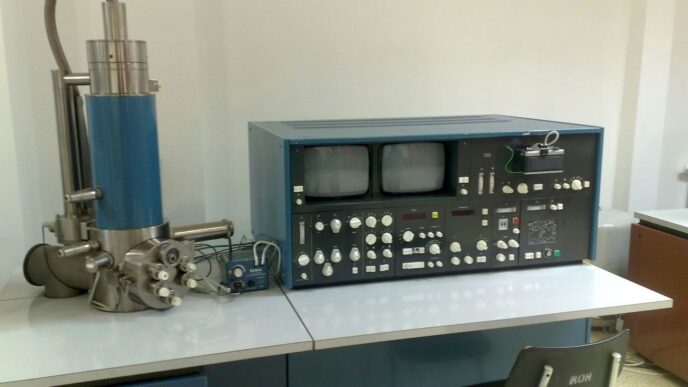There’s some really interesting news coming out of the cancer research world lately, specifically about something called CancerVax. It sounds like they’ve figured out a pretty neat way to get our own bodies to fight cancer. Instead of just attacking the cancer directly, which can be tough on the rest of us, this approach aims to trick the immune system into doing the heavy lifting. It’s like giving the immune system a new set of instructions to spot and eliminate cancer cells. This could be a big deal for how we treat cancer in the future.
Key Takeaways
- CancerVax is developing a new way to treat cancer by making cancer cells look like common infections, which helps the immune system recognize and attack them.
- Recent experiments showed that CancerVax could successfully disguise cancer cells, and these disguised cells activated immune cells, similar to how the body fights off viruses.
- This approach uses mRNA technology to teach the body’s immune cells, specifically T-cells, to identify and destroy cancer cells, a process they call ‘Detect, Mark, and Kill’.
- The company is also working on a specific treatment for Ewing sarcoma and is preparing to move towards clinical trials and FDA applications.
- While still in development, CancerVax represents a potential shift away from traditional treatments like chemotherapy, offering a more targeted and potentially less harmful way to combat cancer.
CancerVax’s Novel Immunotherapy Approach
CancerVax is trying something pretty different in the fight against cancer. Instead of directly attacking cancer cells, which can be tough because they’re so similar to our own healthy cells, they’re aiming to trick the immune system. The basic idea is to make cancer cells look like something the immune system already knows how to fight – like a virus.
Disguising Cancer Cells to Evade Detection
Our bodies are really good at spotting and fighting off foreign invaders, like the measles virus or coronavirus. Cancer cells, however, start out as our own cells, so the immune system often doesn’t recognize them as a threat. CancerVax’s approach involves making these cancer cells appear foreign. They’re using specific protein fragments, kind of like molecular disguises, that are found on common infectious diseases. The goal is to get the immune system to see these disguised cancer cells and react as if they were a dangerous pathogen.
Harnessing the Immune System’s Power
The real power here comes from our own immune system. CancerVax isn’t introducing a new weapon; it’s teaching the body to use its existing defenses more effectively against cancer. By making cancer cells look like a known enemy, they hope to trigger a strong immune response. This response, specifically from T-cells, is what’s needed to identify and eliminate the cancer.
The ‘Detect, Mark, and Kill’ Strategy
CancerVax has a three-part plan: Detect, Mark, and Kill. The current breakthrough focuses on the ‘Mark’ part. They’ve successfully engineered cancer cells to produce proteins that mimic infectious diseases. This effectively ‘marks’ the cancer cells as targets for the immune system. The next steps involve developing the ‘Detect’ phase, likely using nanoparticles to find and deliver these marking signals to the cancer cells, and then relying on the body’s natural ‘Kill’ mechanism to clear the disease.
Groundbreaking CancerVax Experiment Results
So, the big question was: did CancerVax’s clever trick actually work in the lab? The short answer is a resounding yes. The team successfully disguised cancer cells to look like common infections, and the immune system took the bait. This is a huge step forward.
Successful Disguise of Cancer Cells
First off, they needed to make sure the cancer cells were actually producing the fake viral proteins. They used messenger RNA (mRNA) to deliver the instructions into the cancer cells. The results showed that the cells did indeed produce the proteins associated with things like measles and coronavirus. This is what makes the cancer cells appear foreign to the immune system, like an invader it already knows how to fight.
T-Cell Activation on Par with Controls
This is where things got really exciting. To see how well the disguised cancer cells were being recognized, they compared the immune response to a known, strong immune stimulant. They measured the activation of T-cells, which are like the soldiers of your immune system. The CancerVax-treated cancer cells activated T-cells to a level that was comparable to these positive controls. This means the immune system was reacting to the disguised cancer cells just as strongly as it would to a real infection.
Here’s a look at the T-cell activation levels:
| Condition | T-Cell Activation (Relative Units) |
|---|---|
| CancerVax Disguised Cells | 100 |
| Positive Control | 110 |
| Untreated Cancer Cells | 15 |
Validation of the ‘Mark’ Component
All these results really confirm the ‘Mark’ part of CancerVax’s ‘Detect, Mark, and Kill’ strategy. By making cancer cells look like something the immune system already recognizes, they’re effectively marking them for destruction. It’s like putting a big, bright target on the cancer cells so the immune system can find and eliminate them.
This experiment showed that the core idea – tricking the immune system by making cancer cells mimic infectious diseases – is sound. It’s a significant validation of the scientific approach and opens the door for the next stages of development, where they’ll integrate this marking capability with the detection and killing mechanisms.
This success means they can now move forward with confidence, planning to combine these validated proteins into their Smart mRNAs and load them into nanoparticles. The goal is to get these ready for testing in more complex models and eventually, human trials. It’s a complex process, but these results are a very promising sign.
Transforming Cancer Treatment with CancerVax
A Future Beyond Chemotherapy
Imagine a world where cancer treatment doesn’t involve the harsh side effects of chemotherapy or the invasive nature of surgery. CancerVax is working towards making that a reality. Their approach aims to use the body’s own immune system to fight cancer, a method that could dramatically change how we treat this disease. Instead of attacking both healthy and cancerous cells, the goal is to specifically target and eliminate malignant ones. This could mean fewer debilitating side effects for patients and a more effective way to manage the illness.
Potential for Universal Cancer Treatment
The big idea behind CancerVax is a platform that could potentially treat many different types of cancer with a single, adaptable treatment. It’s like having a master key for cancer. The system is designed to ‘trick’ the immune system into recognizing cancer cells as foreign invaders, much like it would a virus. This ‘detect, mark, and kill’ strategy is what makes it so promising for broad application. The hope is that this technology could eventually be customized for various cancers, offering a more unified approach to treatment.
Targeting Ewing Sarcoma
While the universal platform is the long-term vision, CancerVax is also focusing on specific cancers. One of their first drug candidates is aimed at Ewing sarcoma. This is a rare but aggressive bone and soft tissue cancer that often affects children and young adults. Current treatment options for Ewing sarcoma are limited, and the prognosis can be poor. By developing a targeted immunotherapy for this specific cancer, CancerVax is not only advancing their platform but also addressing an urgent unmet medical need. This focused effort is a critical step in bringing their innovative approach closer to patients who need it most.
The Science Behind CancerVax
Mimicking Infectious Diseases
So, how exactly does CancerVax pull off this clever trick? The core idea is pretty straightforward, really. Our immune system is fantastic at spotting and fighting off things like the measles virus or even the common cold. It recognizes them as foreign invaders and goes into attack mode. The problem with cancer is that it starts from our own cells, so the immune system often just doesn’t see it as a threat. CancerVax flips this by making cancer cells look like those familiar infectious diseases. They’ve identified specific protein bits, or epitopes, from common viruses. Then, using mRNA technology, they instruct cancer cells to produce these viral-like proteins on their surface. It’s like putting on a disguise so the immune system says, "Hey, that looks like measles! Attack!" This approach aims to get the immune system to target cancer cells with the same vigor it uses against actual infections.
Utilizing mRNA Technology
Messenger RNA, or mRNA, is the key player in making this disguise happen. You might have heard of mRNA in the context of some recent vaccines. It’s essentially a set of instructions that tells cells how to build specific proteins. In CancerVax’s method, they create mRNA molecules that carry the genetic code for those viral-like proteins they selected. These mRNA molecules are then delivered into the cancer cells. Once inside, the cancer cells read these instructions and start producing the viral proteins. This is a pretty neat way to get the cancer cells themselves to display the ‘wanted’ signs for the immune system, all thanks to the power of mRNA.
Measuring Immune Response
Okay, so they’ve disguised the cancer cells and used mRNA. But how do they know if it’s actually working? That’s where measuring the immune response comes in. The goal is to see if the immune system’s T-cells, which are like the soldiers of our immune army, are getting activated. When T-cells recognize a threat, they release certain signaling molecules, like interferon gamma (IFN-γ). CancerVax scientists measure the levels of these molecules. If there’s a significant increase in IFN-γ after the cancer cells have been ‘disguised,’ it means the T-cells are seeing the cancer cells as foreign and are getting ready to fight. They even compared this activation to a ‘positive control’ – a known way to activate T-cells – and found that CancerVax’s method performed just as well, which is a really big deal.
The science behind CancerVax is all about tricking the body’s own defense system. By making cancer cells mimic common infections, they’re hoping to get the immune system to attack the cancer cells effectively, much like it fights off a virus. It’s a clever way to repurpose the immune system’s natural abilities for cancer treatment.
Advancing CancerVax Towards Clinical Application
So, we’ve seen how CancerVax’s approach works in the lab, which is pretty exciting. But what’s next? Getting a new treatment from a petri dish to actual patients is a long road, and CancerVax is definitely on it. They’re not just sitting back; there are concrete steps being taken to make this a reality.
Next Steps in Nanoparticle Development
The current focus is on refining the delivery system. The idea is to package the mRNA instructions into tiny nanoparticles. These aren’t just any nanoparticles; they’re designed to be smart. They need to find the cancer cells, get inside them, and then deliver the payload – the mRNA that tells the cell to display those
The Evolving Landscape of Cancer Vaccines
Challenges in Cancer Vaccine Development
Developing cancer vaccines isn’t quite as straightforward as the vaccines we get for the flu or measles. Think about it: our immune system is designed to fight off things that are foreign, like viruses and bacteria. But cancer cells? They actually start out as our own cells, just ones that have gone rogue. This makes it tough for the immune system to tell the difference. Plus, every person’s cancer is a bit unique, with its own set of markers, or antigens. This means a one-size-fits-all approach just doesn’t cut it.
Therapeutic vs. Preventive Vaccines
We’ve seen a lot of success with vaccines that prevent diseases. For example, the HPV vaccine helps stop certain viruses that can lead to cancer, and the Hepatitis B vaccine can prevent liver cancer. These are great because they train your body before any cancer has a chance to start. Therapeutic vaccines, on the other hand, are designed to treat cancer that’s already there. They aim to get your immune system to recognize and attack existing cancer cells. It’s a different ballgame, and scientists are working hard to make these therapeutic ones as effective as the preventive ones.
The Promise of Personalized Neoantigen Vaccines
This is where things get really interesting. Since every tumor is unique, researchers are looking at something called neoantigens. These are basically new markers that pop up only on cancer cells due to mutations, and they aren’t found on healthy cells. The idea is to create vaccines that are custom-made for each patient, targeting only their specific cancer cells and leaving healthy tissue alone. This could mean fewer side effects and a more powerful attack against the cancer. It’s a complex process, involving identifying these unique markers and then designing a vaccine to teach the immune system to find them, but the potential is huge.
What’s Next?
So, it looks like CancerVax has really hit on something here. The idea of making cancer cells look like common viruses to trick the immune system into attacking them is pretty wild, but the early results seem to show it actually works. This could mean a future where we don’t have to rely so much on harsh treatments like chemo or radiation. It’s still early days, and there’s a long road ahead with more testing and development, especially for specific cancers like Ewing sarcoma. But this breakthrough is definitely a big step forward, offering a new kind of hope for patients and a potential shift in how we fight cancer.














